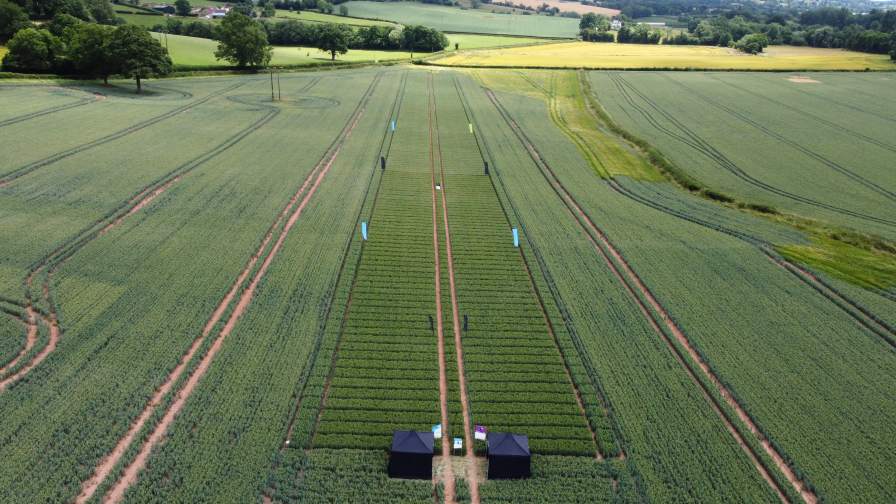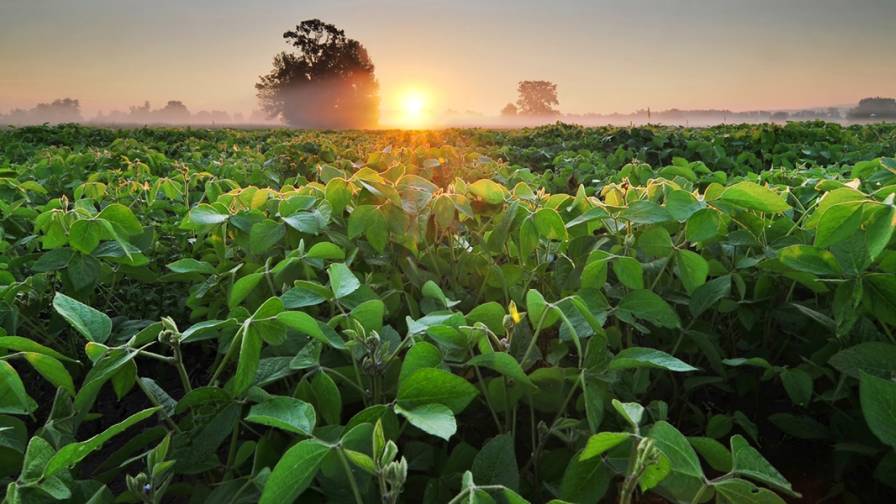Global Perspectives: Agribusiness Association Leaders Share Hopes and Concerns for 2025
Each year, agribusiness leaders from around the globe deal with issues that are common across all of agriculture, regardless of their region of the world. On the flip side, they also have to overcome challenges and seize opportunities that are unique to their region.
With that in mind, AgriBusiness Global asked leaders from 20 associations from around the world to share their hopes and concerns about the upcoming year. View their responses below:
INTERNATIONAL
Emily Rees, President
CropLife International

Emily Rees. Photo credit: CropLife International, Jennifer Lewis
As geopolitical rivalries flare up, there is always the potential for world trade and economic inefficiencies, with some countries more vulnerable to fall-outs than others. Trade is just one geoeconomic considerations within the wider pattern of international fragmentation, but when geopolitical factors play a stronger role in economic decision-making, then markets and regulations can become more unpredictable, less science-based, and more inefficient.
With agricultural markets often bearing the brunt of geoeconomic fall-outs, we need to remain as a steady, informed voice in these debates to ensure that the imperative for resilient food security is never far from sight.
COP30, Brazil. An agricultural powerhouse is hosting a pivotal climate negotiation at a crucial moment, swinging the spotlight firmly onto the Global South. Watch this space!
Jennifer Lewis, Executive Director
International Biocontrol Manufacturers Association (IBMA)

Jennifer Lewis
Plant health is one of the topics keeping farmers awake at night. At the same time, we find ourselves at a wonderful nexus of biological and digital technologies. For example, there is enhanced understanding of soil microbiology, and we have the ability to monitor and adapt farming processes in real time.
We know that farming practices have to change, and this comes with financial risk. Policymakers can incentivize the use of biocontrol, through the CAP in Europe, and food companies can commit to buying from farmers at fair prices.
The biocontrol industry also has a vital role. We need to ensure that farmers have access to the knowledge and know-how needed by putting together pest and disease programs, based on biology, that are effective, reliable, and profitable.
IBMA turns 30 in 2025. This is quite a milestone for us and my wish is for a transformation in agriculture where we embrace all tools available to ensure farmers around the world can use them and are rewarded for working with nature, preserving our biodiversity, and natural ecosystems.
Johan Swinnen, Director General
International Food Policy Research Institute (IFPRI)

Johan Swinnen
Global agriculture, and really larger food systems, face many challenges and opportunities. I would like to focus on just three.
The first challenge is sustainable growth and development. Our world needs to expand food production and raise producers’ incomes. But we also need to curb greenhouse gas emissions for food systems, manage risks from climate change, create jobs (especially for youth), and protect the environment. This is a tall order. Thankfully, we have many evidence-based solutions already at hand. Recently, for example, we partnered with agribusinesses in Nigeria and the government of Japan to evaluate solar-powered cold storage units and fruit and vegetable delivery trucks. We found that this initiative led to better quality and cheaper produce for consumers, and a 33% return for farmers and traders.
The second challenge is nutrition. Global poverty has fallen dramatically, but between 2 to 3 billion people still cannot afford or access a healthy diet. Policy is key here. It determines what foods are produced. How easily they are available in local markets and at what cost. And if households can afford and choose to eat them. Our nutrition work is vast. As a recent example, our researchers in Bangladesh found that the popular parboiled miniket rice has poor micronutrient content, especially for zinc. As a result, the government has introduced policies discouraging its production, transport, and distribution.
The last challenge is equity and inclusion. Global poverty and hunger are concentrated in low-income countries and amongst marginalized population groups, including migrants. Again, I return to policy. Policy choices will influence which countries and people are able to participate in and benefit from growth. For those who face barriers to participating, including gender-based ones, we must provide social safety nets. We evaluate these options. In Egypt, we found that cash transfers under the Takaful and Karama social protection program were effective, leading the program to be continued and expanded to 12 million beneficiaries in 2020.
The time to transform food systems is now. Governments cannot do this alone — they will require the close partnership of the private sector. Agribusinesses can digitize food systems and close the digital divide in agriculture. They can insure farmers against crises and create industrial corridors for food production and free trade of agricultural products. The private sector can allocate venture capital for innovation, provide equal access to financial services, and truly climate-proof food systems for the future. Not only will these actions provide vast economic returns for the private sector, but they will also ensure the health and well-being of people and planet. I remain hopeful for these prospects.
Lloyd Day, Deputy Director General
Inter-American Institute for Cooperation on Agriculture (IICA)

Lloyd Day
Many of the challenges of crop protection and agriculture are cyclical. The big changes coming are both with climate change as well as with feeding a growing population. I see agriculture becoming more front and center in geopolitical issues. For the crop protection industry, with support from governments, it needs to communicate the importance and value of crop protection to feed the world.
We also need to incorporate new ideas. I’m working closely with many crop protection companies to embrace innovation and a forward-looking perspective when it comes to agriculture. We know what’s happened in the past, but we need to see how these new innovations and technologies are going to help us. We need to ensure that we have a regulatory regime, at least in our countries, and also in our trading partners, that will accept these new developments. I was recently at the World Trade organization, where the issue of sustainability, trade, and agriculture was at the forefront in the discussions. I heard talks on sustainability, and how regulations and trading policies might affect the ability of farmers to conduct trade and sell their goods overseas.
There is an upcoming challenge to feed 2 billion more people in the next 25 years, while at the same time reacting to the challenges of climate change. We need to feed the people of today and continue to increase production, while at the same time nurture our soils, rivers, and ecosystems in order to produce food in an efficient way.
Hopefully, we’re going to be able to get on a path toward sustainability and stay there indefinitely. Whether all these predictions will come true in terms of population and climate is to be seen. But for now, we need to harness the innovation that we know is coming from companies. New startups in agriculture are going to help farmers utilize technologies from satellites to drones to gene editing in order to help them with the future of agriculture. They need our support.
AFRICA
Debbie Matteucci, Chairperson
South African Bioproduct Organisation (SABO)

Debbie Matteucci
There is a need for suppliers, distributors, retailers and scientists, even if they are competitors, to be able to come together to improve trust in our industry to benefit growers. There is a bigger picture here and more that can be achieved together as opposed to operating in silos.
We really hope over the next year that we’ll be able to drive that synergy. We aim to be that independent body that’s able to provide answers and guidance for our growers and strengthen key relationships with our local retailers and international markets. We want to be able to grow awareness around biologicals and how they are best used, but specifically to utilize them within an integrated pest management system. This will be the foundation of success for reduced dependence on harmful inputs, improved environmental sustainability, and consumer health.
There is a great movement for the Southern African Development Community (SADC) region to have harmonized guidelines. At SABO, we support this endeavor and hope to see its implementation in the next year, because that will increase the use of biological products across the borders and improve sustainability of agriculture practices across the Southern African region.
ASIA-PACIFIC
Parikshit Mundhra, Chairman
Agro Chem Federation of India (ACFI)

Parikshit Mundhra
I have concerns focusing on the impacts of climate change, soil degradation, and resource depletion. First, climate change poses a significant threat to agricultural productivity through rising temperatures, erratic precipitation patterns, and increased frequency of extreme weather events. These factors can lead to lower crop yields and greater risks of simultaneous crop failures across regions. The need for climate-resilient crops and sustainable water management practices is becoming increasingly urgent.
Second, intensive farming and the overuse of chemical inputs have led to significant soil degradation and biodiversity loss. The depletion of natural resources, particularly water scarcity due to over-extraction and pollution, threatens agricultural sustainability. Many regions face challenges in maintaining or expanding irrigated areas necessary for crop production.
I have several hopes for the upcoming year in India about the advancements significantly transforming agriculture by enhancing productivity and sustainability. First, biostimulants are gaining traction for their ability to improve nutrient use efficiency and enhance plant resilience against abiotic stresses such as drought and salinity. Innovations like microbial inoculants and natural compounds, such as seaweed extracts, further promote plant health and soil vitality.
For drone technology, the Central Insecticides Board (CIB) in India has approved numerous agrochemical formulations suitable for drone-usage, facilitating more efficient and targeted spraying.
Companies are developing innovative pesticide formulations that are more effective and environmentally friendly. The government’s push to expedite approvals for new pesticides aims to enhance crop protection while addressing the challenges posed by insect pests and diseases.
With a rising global demand for Indian agricultural products like rice, spices, and pulses, the government aims to quadruple agricultural exports by 2025. Programs like the Agricultural Export Policy are designed to support this goal, creating opportunities for investment in infrastructure such as cold storage and logistics that facilitate export-oriented farming.
Investments in rural infrastructure — such as roads, seaports, electricity, and digital connectivity are set to improve market access for farmers. Enhanced infrastructure will lower transportation costs and boost the overall efficiency of the agricultural supply chain. This development is crucial for supporting both traditional farming and agritech innovations.
Sun Shubao, President
China Crop Protection Industry Association (CCPIA)

Sun Shubao
I hope that the global crop protection industry will place more emphasis on innovation in 2025. In particular, I hope that breakthroughs will be made in intelligent agriculture and precision pesticide application. Chinese pesticide enterprises can apply pesticides more precisely by introducing digital agricultural technology, thus reducing resource waste and environmental impact. Meanwhile, I hope that the global crop protection market will recover as soon as possible. In view of the fact that pesticides are agricultural consumables and factors such as population and energy, I believe that the global demand for efficient, slightly toxic and sustainable pesticides will keep growing. I’m hopeful it will recover soon.
What I’m concerned about is that as global environmental protection laws become increasingly stricter, the pesticide industry will be under great compliance pressure, especially in Europe and North America. Besides, factors such as uncertainties of the global supply chain, fluctuations in raw material prices and technical barriers may lead to rising costs for the industry. How to deal with those problems and reach a global consensus to ensure sustainable supply and use of pesticides is a big concern.
The Chinese pesticide industry should strengthen education and training to farmers and employees in the industry to make sure that they can safely and effectively use pesticide products. By promoting cooperation between the government, enterprises and industry associations, setting up training programs and promoting scientific and safe pesticide use technology, it can not only raise the output and quality of crops but also reduce pesticide misuse and abuse.
The Chinese pesticide industry will face many challenges as well as great development opportunities in 2025. Through green development and the internationalization strategy, the industry is expected to play a bigger role in the global crop protection market.
SiangHee Tan, Executive Director
CropLife Asia

SiangHee Tan
Looking ahead to 2025, the hopes for agriculture in Asia are centered on the successful scaling of sustainable agricultural practices and the timely availability of climate-smart technologies to smallholders. The ability to implement these changes at scale is crucial for addressing the pressing challenges of climate change, resource depletion, and food security. There is hope that with the right support, smallholder farmers can become agents of change, driving the adoption of sustainable practices and technologies that benefit both the environment and their communities.
However, there are also significant concerns. The primary concern is whether the necessary infrastructure, funding, and policy support will be in place to facilitate these changes effectively. Without coordinated efforts at the local, national, and global levels, the benefits of innovation may not reach those who need them most. Additionally, there is the risk that without adequate education and resources, smallholders may struggle to adopt new practices, leading to a widening gap between those who can and cannot adapt to the changing agricultural landscape.
CropLife Asia’s goals for 2025 reflect a strategic approach to addressing these challenges, emphasizing the importance of sustainable pesticide management and the empowerment of smallholder farmers through innovation. Achieving these goals will be critical to ensuring a resilient and sustainable agricultural future for Asia and the world.
Pradip Dave, President
Pesticides Manufacturers & Formulators Association of India (PMFAI)

Pradip Dave
With wide variety of crops grown in the Asian region including India and China, agricultural production has been increasing in variety and volume. Presently, India ranks as the second largest producer of fruits, vegetables, tea, sugarcane, wheat, rice and sugarcane. We look forward to further increasing agricultural and horticultural productivity in 2025 not only to ensure food security of India but also to contribute to the global demands.
Major concerns for agriculture is climate change and changing weather patterns, which can introduce new pests and diseases or alter their prevalence, requiring adaptive strategies in crop protection. Conversion of rural land for urban development is another major concern. As the global population is growing, demand for food and other agricultural products is increasing, which puts pressure for maximum productivity from available land and use of advanced technologies is the only answer.
EUROPEAN UNION
Arne Pingel, President
European Biostimulants Industry Council (EBIC)

Arne Pingel
I remain concerned about the situation of farmers in Europe, who are experiencing difficulties caused by economic, environmental, and social factors. They need competitive pricing, better financial support, and incentives to adopt sustainable practices. Policies should simplify regulations and promote innovation, while fostering community support and mental health resources to strengthen rural livelihoods.
EBIC will play its part in pushing policymakers, but again, it will take effort and collaboration across the whole food supply chain to get behind our farmers and help them feed the world while staying profitable.
Pankaj Patil, President
European Crop Care Association (ECCA)

Pankaj Patil
Following this year’s horrific floods in central and eastern Europe, as well as other weather anomalies across the continent, we believe that climate change – and how we respond and adapt to it – will dominate Europe’s agricultural sector in 2025.
With this in mind, we are especially worried about the lack of regulatory action in Brussels that would better support the post-patent plant protection industry, limiting access to products essential for farmers’ ability to protect their livelihoods against climate change.
Outside Europe, I believe that climate change is also set to dominate the minds of farmers and policymakers responsible for protecting the agricultural sector. On this point, we may see greater regulatory disparities globally that could hinder European competitiveness compared to countries like the U.S., India, and China, which often have more streamlined approval processes for plant protection products.
LATIN AMERICA
Juan Manuel Pérez Echeverría, President
Asociacion Latinoamericana de la Industria Nacional de Agroquimicos (ALINA)

Juan Manuel Pérez Echeverría
We’re optimistic that agricultural commodity prices will remain stable, enabling Latin American farmers to better navigate new regulations and meet market demands. One key area of hope is the successful implementation of zero-deforestation certifications and other sustainability measures, ensuring profitability while aligning with global environmental goals.
Some of our concerns are around how the new U.S. administration will influence global trade policies. Changes to agricultural exports or stricter regulations could significantly impact markets. Another concern is the financial strain on farmers. Adapting to new regulations often requires significant investment, which could particularly hurt smaller farms and businesses. Finally, we worry about how global economic shifts might affect agricultural economies, especially in export-dependent regions.
These uncertainties make it crucial to remain vigilant and adaptive. Three points to consider in the upcoming year is addressing emerging barriers to entry, balancing innovation with accessibility, and advocating for fair policies.
Large corporations, facing shrinking profit margins due to rising costs, may create new barriers to entry. This could be a challenge for small and medium-sized enterprises (SMEs) that often have more efficient cost models but fewer resources.
It’s also critical to ensure that new technologies remain accessible to smaller companies and farmers. If only larger players can adopt them, we risk further consolidating the industry.
Finally, collaboration between governments, businesses, and farmers will be key to ensuring fair trade practices and manageable compliance costs for all parties. By addressing these challenges proactively, we can foster a thriving, equitable agricultural sector in the coming years.
Mauricio D’Acunti, President
National Chamber of Fertilizers and Agrochemicals of Uruguay (CANAFFI)
In 2025, our concerns are for growers of Latin America in the face of geopolitical issues. Their production must be sustainable. After world instabilities, such as the wars in Ukraine and Russia and Middle East and U.S. political elections, we are concerned about food safety and security.
Another concern is the price of the commodities (meat, wheat, corn, rice and soybean) that have been suffering endless drops in prices.
Uruguay also has the challenge of a new insect in maize (Daubulus Maidis). It showed up last year and caused several losses for farmers. Therefore, the Ministry of Livestock, Agriculture and Fisheries authorized several active ingredients to fight against this insect, noticing there were no showing Daubulus Maidis labels in the market.
José Perdomo, President
CropLife Latin America

Jose Perdomo
While we are just seeing the dust settle after 2024 mega election year, the multilateral space is very dynamic and Latin America has been center stage. We are only processing results from the CBD COP16, just as we gear for UNFCCC COP29 and G20 meeting. Both domestic and multilateral processes will shape the future of influential policies for global agriculture. Regionalism versus multilateralism, tariffs, protectionism, will certainly play a role.
In the current context of heightened concern for biodiversity, climate change adaptation, and food security, it is essential to adopt innovations, digitize agriculture, and use inputs more responsibly.
We need to demonstrate that agriculture with innovation and technology are part of the solution of the world challenges and not the problem. Therefore, by 2025, we aim to train 250,000 people on this topic and recover more than 85,000 tons of empty pesticide containers.
Gabriel Ormeño Hofer, President

Gabriel Ormeño Hofer
Trade Association of Importers and Producers of Phytosanitary Products, Fertilizers and Biostimulants for Agriculture (IMPPA)
We hope to promote the growth of the partners’ portfolio of biorational solutions.
The concern of our region for 2025 is the increase of active ingredient bans by LATAM governments and regulatory bodies, especially in Europe. There is not the same criteria. There is also no clear timeline as to which ones will be eliminated, in order to look for alternatives that can replace them.
Dr. José Ignacio Escalante de la Hidalga, President
Mexican Union of Agrochemical Manufacturers and Formulators (UMFFAAC)

Dr. José Ignacio Escalante de la Hidalga
The Mexican judiciary was severely affected by the previous government. Various figures from the United States have expressed their deep concern about the lack of transparency expected in Mexico’s judiciary.
It is feared that there is no legal certainty. This may seriously affect the results of the very upcoming review of the free trade agreement. We will see if the Mexican government persists in modifying the judicial power and the treaty, on which about 35% of our GDP depends, would be greatly affected.
For the UMFFAAC, the export of vegetables, fruits and flowers is extremely important. As an organization we are in favor of strengthening the field and its exports, but we consider that we would have lower exports if the rules of the treaty change and tariffs on these products are established or raised.
Never since true democracy was established have we depended so much on our leaders rising to the occasion.
UNITED STATES
Daren Coppock, President
Agricultural Retailers Association (ARA)

Daren Coppock
All of agriculture needs to push trade issues in 2025. This applies both inbound and outbound: access to markets for our ag product exports and also access to inputs like pesticide technical ingredients and fertilizer products.
We remain very dependent on offshore chemical manufacturing to obtain these input products, and that situation will not change quickly, if at all. It’s very clear to me that an aggressive U.S. policy of import tariffs and protectionism will have very negative impacts on the U.S. agriculture sector. Other countries retaliate on U.S. ag exports.
Our sector also needs some focused effort on expanding trade opportunities globally. This was not a priority in the Biden Administration, and so we are now four years behind our competitors in the global marketplace.
Keith Jones, Executive Director
Biological Products Industry Alliance (BPIA)

Keith Jones
BPIA’s hopes for agriculture in North America and the world in 2025 are to see an increase in the growing adoption and use of all kinds of biological products, not just in commercial agriculture but in many areas including home gardens, forestry, and even public health. To help encourage this, BPIA is working to promote adoption of the AAPFCO Model Bill and ensure implementation results in a clear path to market for biostimulants at the state level.
In 2025, BPIA also intends to create an outreach communication campaign to increase understanding of the value of biological products to a variety of audiences. One concern that BPIA has is that the United States Environmental Protection Agency is adequately funded by Congress so that the agency can continue to register new and innovative biological products. To address this concern, BPIA will focus much of its advocacy work on Capitol Hill on this issue.
Terry Kippley, President
Council of Producers and Distributors of Agrotechnology (CPDA)

Terry Kippley
Right now, the U.S. agriculture industry is facing some significant headwinds. Commodity prices are down, inflation is up, and we have experienced our fair share of natural disasters. Without a new farm bill, many growers will have a difficult time weathering this current downturn in the agricultural economy. Our members, however, help provide affordable choices in the marketplace in addition to the use of important tools like adjuvants that help stretch their crop protection dollar further along with providing a low-cost option for ESA mitigation and compliance.
Collaboration is the new currency in Washington D.C. and across the country. There is no going it alone anymore. CPDA is committed to working with our partners, like our state Departments of Agriculture and grower groups, to ensure that farmers and our industry have the resources they need to be successful.
Alex Dunn, President
CropLife America

Alex Dunn
U.S. farmers depend on pesticides to grow healthy and safe crops, fruits, and vegetables that are used as food, as well as other farm products, including fibers, lumber, and fuel for consumers domestically and around the world.
Many U.S. grown crops are exported, and pesticide-related trade barriers have become increasingly challenging to U.S. growers and CropLife America, as well as food importers to the U.S. We support global science-based approaches that uphold consumer and crop safety and promote fair trade practices for imports and exports.
Our hope is that divergent regulatory approaches continue to be addressed so that U.S. farmers whose commodities are exported can continue to use EPA approved products and maintain open channels of trade through rules-based trade.
As a leader on global sound science and risk-based regulatory approach for agriculture chemistry, EPA’s participation in dialogues where chemical regulation is discussed and negotiated is important to support U.S. farmers’ access to tools and trade markets.






